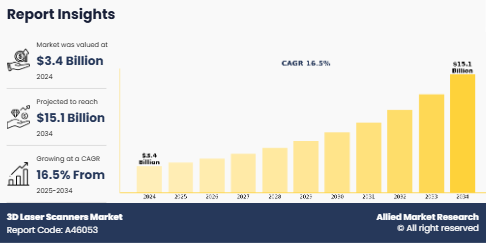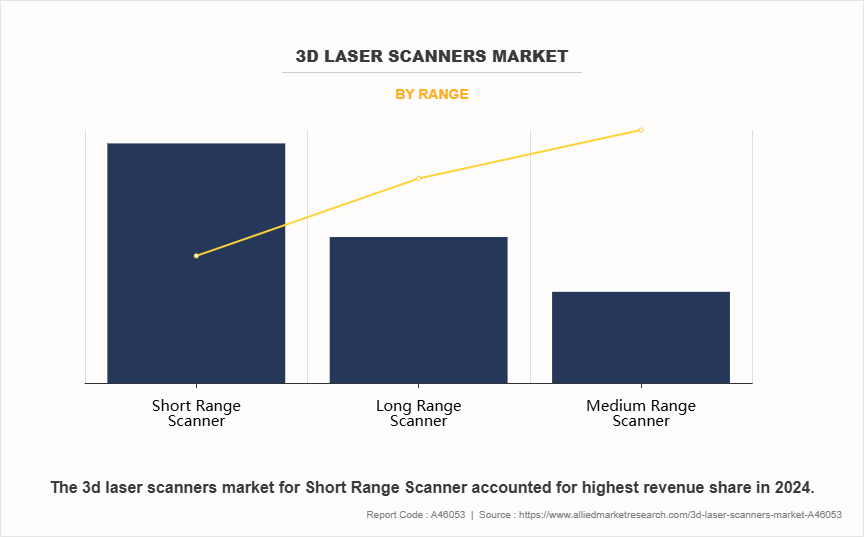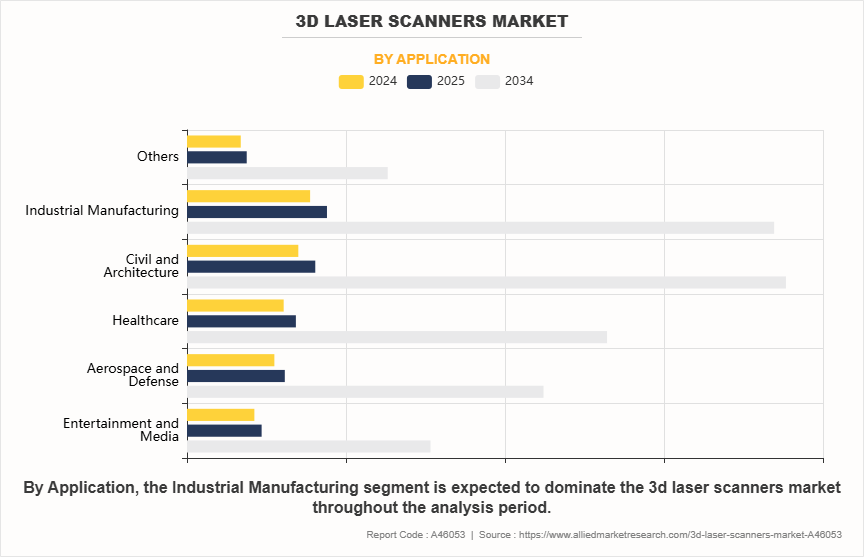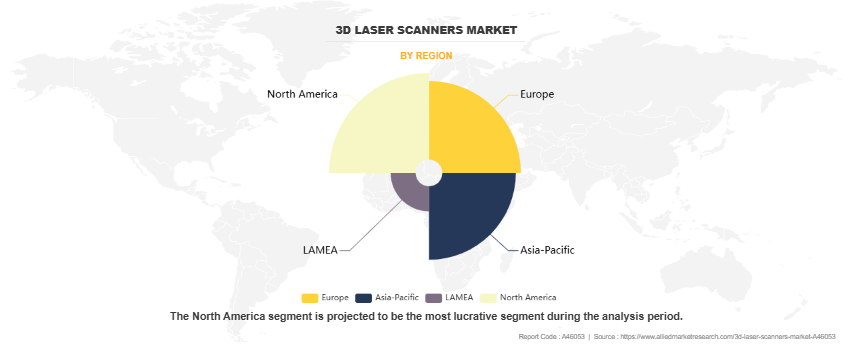3D Laser Scanners Market Research, 2034
The Global 3D Laser Scanners Market was valued at $3.4 billion in 2024 and is projected to reach $15.1 billion by 2034, growing at a CAGR of 16.5% from 2025 to 2034.
A 3D laser scanner is an advanced measurement tool that uses laser technology to capture precise three-dimensional data about physical environments and objects. The device operates on the principle of light reflection, where the scanner sends out laser beams that bounce off different surfaces before returning to the device. The scanner accurately calculates distances by measuring the time taken for the light to return, resulting in the generation of a dense point cloud. This point cloud comprises millions of data points representing the scanned object or environment in three-dimensional coordinates, effectively creating a detailed digital model.
The applications of 3D scanners are widespread across multiple industries, which consist of construction, architecture, archaeology, engineering, and manufacturing. In addition, in the construction sector, 3D laser scanners facilitate the creation of as-built documentation, providing accurate measurements for project planning and execution. Over the past few years, companies like Autodesk have integrated laser scanning with Building Information Modeling (BIM) software to streamline workflows and enhance precision in project designs.

In the field of archaeology, the use of 3D laser scanners permits researchers to digitally record and preserve artefacts and excavation sites, thereby offering a valuable resource for study and analysis that is immune to physical deterioration. For example, the laser scanning of ancient ruins at Pompeii facilitates understanding of the site's structure and the impact of volcanic eruptions over the years.
Besides, in the manufacturing sector, organizations are increasingly adopting 3D laser scanners for quality control and inspection processes. Recent advancements consist of the integration of 3D scanning with artificial intelligence for enhanced data analysis, such as ensuring the accuracy of intricate components in aerospace engineering. Hence, 3D laser scanners continue to advance, fueling innovation and efficiency across various fields by enabling the creation of detailed and accurate digital representations of the physical world.
The 3D laser scanners market size is experiencing robust growth fueled by several factors, such as the surge in technological advancements in laser scanning technology, which consists of higher accuracy, faster scanning speeds, and enhanced data processing capabilities. These improvements have expanded the usability of 3D laser scanners across various industries, such as automotive, aerospace, healthcare, and construction. Another significant factor is the increasing adoption of 3D laser scanners in quality control and inspection processes. Manufacturers are utilizing these devices to guarantee precision and accuracy in their products, thereby reducing errors and improving production performance. In addition, the integration of 3D laser scanners with other digital tools, such as CAD software and augmented reality, has further boosted its application in design, prototyping, and maintenance.
The increasing demand for 3D laser scanners in the healthcare sector is one of the prime factors driving the 3D laser scanners market growth. These scanners are used for medical imaging, prosthetics, and orthotics, permitting healthcare professionals to create detailed 3D models of organs and tissues, which have significantly improved surgical planning and patient care. For example, on May 29, 2024, Polyga, a global leader in 3D scanning research and development, highlighted the way in which 3D scanning is revolutionizing orthopedics. This technology enables the development of custom implants and prosthetics that fit accurately to patients' anatomies. In cardiology, 3D scanning has also transformed surgical planning by providing accurate models of the heart. These models give surgeons valuable insights into cardiac conditions, enhancing the accuracy of complex procedures and making them safer. Hence, the use of 3D laser scanners results in better-fitting implants and prosthetics in orthopedics, which improves surgical outcomes and speeds up recovery times. In cardiology, the detailed models support surgeons in understanding patients' heart conditions and planning surgeries with greater precision.
Moreover, the rise in infrastructure development projects globally has increased the need for accurate and efficient surveying and mapping technologies, thereby fueling the growth for 3D laser scanners market outlook. For instance, on March 10, 2025, in a report by Architectural Insights, the CEO of the company Emily Johnson highlighted the use of 3D laser scanners in the construction of a new smart city in Dubai. The project required precise surveying and mapping to ensure the accurate placement of buildings, roads, and utilities. The use of 3D laser scanners allowed engineers to develop detailed topographical maps and 3D models of the terrain, significantly improving the performance and accuracy of the construction process. This showcases the growing importance of 3D laser scanners in large-scale infrastructure projects, where precision and efficiency are essential.
Segment Overview
The 3D laser scanners market is segmented into application, range, and region.

By range, the 3D laser scanners market is divided into Short-Range Scanners (Up to 1 meter), Medium-Range Scanners (1 to 150 meters), and Long-Range Scanners (150+ meters). The Short-Range Scanners accounted for a major share of the market, and the medium-range segment is expected to grow at a high rate during the forecast period.

Based on application, the market is segmented into entertainment and media, aerospace and defense, healthcare, civil and architecture, industrial manufacturing, and others. The civil and architecture segment dominated the market in the year 2024 and is expected to dominate the 3D laser scanners market during the forecast period.

Region-wise, the 3D laser scanners market is analyzed across North America (the U.S., Canada, and Mexico), Europe (UK, Germany, France, Italy, and rest of Europe), Asia-Pacific (China, Japan, India, South Korea, and Rest of Asia-Pacific), and LAMEA (Latin America, the Middle East, and Africa).
Competitive Analysis
The key players profiled in the global 3D laser scanners market consist of Hexagon AB, FARO Technologies, Inc., Trimble Inc., Nikon Corporation, Carl Zeiss AG, Maptek, TOPCON CORPORATION, Perceptron, Inc., ZEISS Group., and Creaform. The top 3D laser scanners market. For instance, in March 2025, Hexagon's Manufacturing Intelligence division launched the Absolute Scanner AS1-XL, a modular 3D laser scanner designed for large surface inspection. It is suitable for handheld and automated robotic applications, offering high precision and flexibility.
Moreover, the 3D laser scanners market share is significantly dominated by ABB Ltd., Siemens AG, Prysmian Group, TE Connectivity, and Nexans, owing to their extensive product portfolios, strong global presence, and continuous innovation in 3D technologies.
Recent Developments in 3D Laser Scanner Industry
- In March 2025, FARO introduced the Focus Premium Max, which extends the scanning range to 400 meters and reduces scanning time by up to 50% with their Hybrid Reality Capture technology. This new scanner aims to enhance efficiency and accuracy in large-scale projects.
- In February 2025, Trimble announced the X9 3D laser scanning system, offering longer range, higher accuracy, and shorter scan times. This system is designed to improve performance in various environments, making it versatile for different applications.
- In October 2024, Nikon sold its laser scanning and Focus Inspection software business to LK Metrology. This move ensures continued development and support for Nikon's 3D measurement technology under new management.
- In February 2025, FARO Technologies and Topcon Corporation announced a strategic agreement to develop and distribute innovative laser scanning solutions. This collaboration aims to combine their expertise to advance technological capabilities for professionals across multiple industries.
Key Benefits For Stakeholders
- This report provides a quantitative analysis of the 3D laser scanners industry segments, current trends, estimations, and dynamics of the 3D Laser Scanners market analysis from 2024 to 2034 to identify the prevailing 3D laser scanners market forecast.
- The 3D laser scanners market research is offered along with information related to key drivers, restraints, and opportunities.
- Porter's five forces analysis highlights the potency of buyers and suppliers to enable stakeholders to make profit-oriented business decisions and strengthen their supplier-buyer network.
- In-depth analysis of the 3D laser scanners industry segmentation assists in determining the prevailing 3D laser scanners market opportunity and growth factors.
- Major countries in each region are mapped according to their revenue contribution to the global 3D laser scanners market outlook.
- Market player positioning facilitates benchmarking and provides a clear understanding of the present position of the 3D laser scanners market players.
- The report includes the analysis of the regional as well as global 3D laser scanners market trends, key players, 3D laser scanners market segments, application areas, and 3D laser scanners market growth strategies.
3D Laser Scanners Market Report Highlights
| Aspects | Details |
| Market Size By 2034 | USD 15.1 billion |
| Growth Rate | CAGR of 16.5% |
| Forecast period | 2024 - 2034 |
| Report Pages | 346 |
| By Application |
|
| By Range |
|
| By Region |
|
| Key Market Players | FARO Technologies, Inc., Perceptron, Inc., Creaform, ZEISS Group, Nikon Corporation., Maptek, Carl Zeiss AG, TOPCON CORPORATION, Hexagon AB, Trimble Inc. |
Analyst Review
According to the perspectives of CXOs from leading companies, the 3D laser scanner market is expected to grow in the coming years, owing to various factors, including the rise in demand for Internet of Things (IoT) solutions across industrial and commercial sectors globally is driving the need for next-generation 3D laser scanning solutions. Moreover, prime economies such as the U.S., China, Germany, and Japan are developing and deploying next-generation 3D laser scanning solutions across various sectors such as automotive, manufacturing, healthcare, and hospitality.
Technological advancements, such as the integration of artificial intelligence (AI) and machine learning, are expected to provide new avenues for advanced analytics, predictive maintenance, and decision-making capabilities. These technologies appeal to industries seeking operational efficiency and are likely to drive 3D laser scanners' market growth. Additionally, the push toward digital transformation and Industry 4.0 integration has made real-time monitoring, predictive maintenance, and optimized workflow management crucial for companies looking to stay competitive.
Among the analyzed geographical regions, North America exhibits the highest adoption of 3D laser scanners and has been experiencing significant 3D laser scanners market expansion. On the other hand, Asia-Pacific is expected to grow at a faster pace, predicting lucrative growth due to emerging countries such as China, Japan, and South Korea investing heavily in these technologies. Regions such as the Middle East and Africa are expected to offer new opportunities for the growth of the 3D laser scanner market in the future.
Globally, various key players and government agencies are investing in 3D laser scanning technology to make it compatible with various industrial platforms. For instance, on August 17, 2021, FARO Technologies, a leading provider of 3D measurement and imaging solutions, announced plans to enhance its product offerings with advanced features aimed at increasing productivity and accuracy. In addition, on October 25, 2021, Hexagon AB, a major player in the 3D laser scanner market, announced an investment package worth $929 million to develop next-generation scanning solutions.
The global 3D laser scanner market is highly competitive, with key players such as FARO Technologies, Hexagon AB, Trimble Inc., Leica Geosystems (part of Hexagon), Topcon Corporation, and Nikon Metrology NV driving innovation and growth. These companies are continuously investing in research and development to introduce advanced solutions that enhance productivity and accuracy across various applications.
In addition, the 3D laser scanner market is poised for significant growth, driven by technological advancements, increasing adoption across various industries, and strategic investments by key players and government agencies. The competitive environment in this market is expected to further intensify with the increase in technological innovations, product extensions, and different strategies adopted by key vendors. Industry experts believe that these factors will significantly propel the growth of the market, creating new opportunities and driving the adoption of 3D laser scanning technology globally.
North America is the largest regional market for 3D laser scanners, leading the global market with the highest market share.
The integration of AI and machine learning is enhancing the accuracy and efficiency of 3D scanning processes.
The global 3D laser scanner market was valued at approximately $3.3 billion in 2024 and is projected to grow at a CAGR of 16.5% from 2024 to 2030.
The leading application of 3D laser scanners is in the Civil & Architecture sector, driven by the high demand for accurate 3D models in construction and urban planning.
The top companies holding market share in the 3D laser scanners market include Hexagon AB, FARO Technologies, Inc., Trimble Inc., Nikon Corporation, and Carl Zeiss AG.
The top companies holding market share in the 3D laser scanners market include Hexagon AB, FARO Technologies, Inc., Trimble Inc., Nikon Corporation, and Carl Zeiss AG.
Loading Table Of Content...
Loading Research Methodology...



